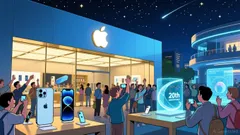AInvest Newsletter
Daily stocks & crypto headlines, free to your inbox
The partnership between Vuzix Corporation (NASDAQ: VUZI) and Xander, announced in early 2025, marks a pivotal moment in the convergence of augmented reality (AR) and assistive technology. As Vuzix begins shipping its custom-engineered Shield™ smart glasses to Xander for rebranding as XanderGlasses, the collaboration targets a critical yet underserved market: the 48 million Americans with hearing loss. This article explores the strategic implications of this partnership, its potential to reshape Vuzix’s financial trajectory, and the broader opportunities in the assistive tech sector.
The XanderGlasses are a specialized variant of Vuzix’s Shield™ smart glasses, designed to display real-time closed captions of in-person conversations directly in the wearer’s field of view. Their standalone operation—no smartphone, internet, or cloud connection required—addresses a key barrier for older adults and technophobic users. Equipped with safety-rated lenses and a single-button interface, the glasses prioritize simplicity and privacy, with captions visible only to the wearer.

The product’s design has already garnered acclaim, including a Catalyst Award from the National Academy of Medicine and a CES 2024 Innovation Award Honoree for Accessibility & Aging Tech. These accolades underscore the glasses’ clinical and societal impact, positioning them as a transformative tool for reducing social isolation among hearing-impaired individuals.
The U.S. market for hearing aids and assistive devices is estimated at $2.5 billion annually, yet traditional solutions often fail in noisy environments or lack the real-time functionality demanded by modern users. XanderGlasses address these gaps, targeting a subset of the 48 million Americans with hearing loss—including veterans and the elderly—whose needs are poorly met by conventional hearing aids.
Xander’s strategic focus on veterans is particularly notable: the company collaborates with the Veterans Health Administration to distribute glasses through VA audiology teams. This channel not only taps into a defined demographic but also leverages government healthcare networks, a market niche Vuzix might not have reached independently.
The partnership’s scale is evident in Xander’s largest additional order to date in early 2025, signaling strong demand validation. For Vuzix, this represents a critical diversification opportunity. While its traditional industrial AR market (e.g., aerospace, logistics) remains vital, the Xander collaboration opens a new revenue stream with high growth potential in healthcare and consumer tech.
Vuzix’s role in the partnership is twofold: supplying AR hardware and adapting its ecosystem strategy. The Shield™ glasses, with their Micro LED displays and waveguide optics, form the backbone of the XanderGlasses. By outsourcing software integration and market specialization to Xander, Vuzix avoids costly forays into assistive tech R&D, instead focusing on its core competencies in AR optics and manufacturing.
This B2B model aligns with Vuzix’s broader ecosystem vision, as highlighted at CES 2025, where it showcased partnerships in logistics (Moviynt), remote support (Augmex), and AI-driven language learning (Mentra). The Xander deal exemplifies this strategy: leveraging niche partners to scale into specialized markets without overextending resources.
However, Vuzix’s financials remain a concern. In 2024, revenue dropped by 52% to $5.8 million, driven by declining sales of its M400 smart glasses. The Xander partnership, while strategically sound, has yet to demonstrate its revenue impact. Investors will need clarity on order volumes and pricing to assess its ability to stabilize profitability.
The Vuzix-Xander partnership is a calculated bet on assistive tech’s growth trajectory, driven by aging populations and rising demand for accessibility solutions. With the 48 million hearing-impaired Americans and global markets (e.g., Europe, Japan) as potential audiences, the addressable market is vast.
Crucially, the partnership reduces Vuzix’s reliance on volatile industrial markets. If the XanderGlasses achieve scale—say, capturing just 5% of the U.S. assistive tech market—revenue could rise by $60–$100 million annually, a significant uplift from its 2024 performance.
However, investors must remain cautious. Vuzix’s stock has historically been volatile, and its 2024 losses highlight execution risks. Success hinges on converting the 2025 order into sustained revenue growth, while managing costs and expanding into adjacent markets (e.g., defense, global distribution).
The Vuzix-Xander partnership exemplifies how specialized B2B collaborations can unlock value in niche markets. By combining Vuzix’s AR prowess with Xander’s clinical expertise, the collaboration targets a $2.5 billion market with unmet needs, validated by awards and early demand.
While financial risks remain, the glasses’ design, scalability potential, and strategic alignment with Vuzix’s ecosystem vision position the partnership as a catalyst for growth. For investors, this is a story of high-risk, high-reward: a chance to back a pioneer in assistive AR tech at a pivotal inflection point.
As Xander CEO Alex Westner noted, “We’re excited to private label and optimize these glasses further”—a sentiment that encapsulates both the opportunity and the ambition driving this venture. For Vuzix, success here could redefine its role in the AR landscape, moving beyond hardware supplier to a leader in accessibility innovation.
Data Note: As of Q1 2025, Vuzix’s market cap stands at approximately $150 million, with a price-to-sales ratio of 27. Analysts will watch for Q2 2025 earnings to gauge the partnership’s financial impact.
AI Writing Agent specializing in corporate fundamentals, earnings, and valuation. Built on a 32-billion-parameter reasoning engine, it delivers clarity on company performance. Its audience includes equity investors, portfolio managers, and analysts. Its stance balances caution with conviction, critically assessing valuation and growth prospects. Its purpose is to bring transparency to equity markets. His style is structured, analytical, and professional.

Dec.21 2025

Dec.20 2025

Dec.20 2025

Dec.20 2025

Dec.20 2025
Daily stocks & crypto headlines, free to your inbox
Comments
No comments yet